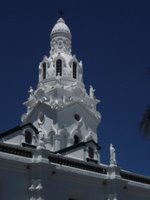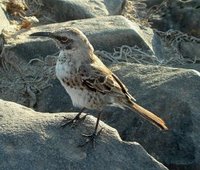 Punta Moreno
Punta MorenoOn Tuesday morning, we arrived at Punta Moreno, on Isabela. During the briefing before landing, Mauricio warned us that this would be a dry landing on very jagged and uneven lava. (The boulders on Espanola would seem easy compared to this.) As the pangas pulled up to the island, I wasn't even sure how I was going to scramble up the cliff. Usually there is something that at least resembles steps - this time - no. I almost considered getting back into the panga and going back to the yacht, but it was even scarier turning around than going up. Once I reached the top, I looked out and saw a vast expanse of the same rough, brittle, pahoehoe lava. In my mind, walking across lava was going to be like walking across blacktop with lots of cracks. Boy was my mind wrong!
After a few minutes of struggling with trying to figure out where to step, Mauricio decided that it

would take a month for me to walk the trail on my own. He told me to grab his hand and stay to his right, and he would lead me through the trail. On one hand I was very thankful that I had his help, but on the other hand I kind of felt like a dork. Like a blind dork. I even commented that I felt like I was blind, with him leading me by the hand and my walking stick clicking against the lava in the other hand.
There were a few areas where the lava flattened, but most of the time, my ankle and knee were at weird angles. There were also quite a few ledges and crevices. The crevices usually weren't more than a foot wide, although they were really deep.

The ledges were on edges of cliffs filled with sharp pointy lava - and sometimes pools of brackish water filled with sharks! Mauricio kept steering me towards the ledges and I kept trying to follow behind him, rather than beside him. Every now and then he would "yell" at me for not walking where I was supposed to, since he claimed the edge of the ledge was more solid than where he was walking. I knew I should trust him, but I really didn't want to end up at the bottom of one of those cliffs!
While there wasn't that much to see on the surface of the island

(a few small plants and cactus), there was a lot to see at the bottom of the cliffs. Those areas often filled with brackish water (salt water from the ocean running up fissures in the lava, and fresh water running down from the volcanoes). Small fish and sharks would get into these pools through the fissures with the salt water, then grow too big to escape back to the sea, getting trapped.

Lots of plants grew along the edges of these pools, and the water attracted flamingos, stilts, martins, and other shore birds.
After the walk was over, came the part I was dreading the most. Getting back down the cliff and into the panga. My descent was less than graceful, and I basically fell into the boat. I can't begin to tell you how happy I was to get back on the yacht!
After we were all back on the Beluga, the captain turned on the engine and we started moving to Elizabeth Bay. We ate lunch while the yacht was moving, which was quite an experience in itself. Most of the time, meals were served when the yacht was anchored.
Elizabeth Bay, IsabelaShortly after lunch, we dropped anchor and went snorkeling at Elizabeth Bay. There were a couple of penguins zipping by, but they were very difficult to capture on film. There were also a few flightless cormorants, which were equally quick swimmers. As we moved closer to the rocky/lava shoreline, there were all sorts of inlets to explore.
There was one narrow channel that led to smaller pools surrounded by lava. Getting through that was difficult, since the tide was going out, and you really had to swim against the current (and push off against the rocky bottom). Once it that area, there was a mix of brackish water

- it almost looked like we were snorkeling in oil, since the mix of fresh and salt water caused a filmy cloud. This made taking pictures rather difficult.
As we moved further inland, there was one area that Mauricio told us not to miss. He made it all very mysterious, saying that we couldn't wear our flippers or kick our feet in that area, and only 3 people could enter at a time. He then swore the leaving people to secrecy, so they couldn't tell anyone else what they saw. In order to get into this area though, you needed to take off your flippers, and walk about 3m across the same sharp, uneven lava that we walked across earlier in the morning. Sheesh! I could barely walk across that with shoes - let alone barefoot. Several other people were equally hesitant to walk across that lava, so we problem solved and made a path with our flippers. That way, even though the sharp lava was underfoot, our feet were actually touching the rubber flippers. Mauricio assured us it was worth the effort. IT WAS! In addition to all sorts of fish, there were about a half dozen sea turtles in an area about the size of my bedroom, gracefully swimming along beside us. What an incredible experience.

After hauling ourselves back out of the water and into the pangas, we headed back to the yacht for a warm snack and to change clothes. We had about an hour to dry off and warm up, before we hopped back into the pangas for a ride through the mangroves. The crew also brought the kayaks out, so people could use those if they wanted (there were 2 kayaks for everyone to share).
It was amazing how close we could get to the wildlife in the pangas.

Once we got into the mangroves, the motor was cut and the driver pulled out oars, so we could paddle silently in the water. Through the water, we could see sea turtles and a few sting rays, but the real interest was on the shore.

At one point, we came across a group of penguins on the shore. I was close enough that I would have been able to touch them! In fact, I ended up holding onto a branch of the tree they were under in order to keep the panga still, and stop it from bumping against the shore with each wave. It was amazing to see the amount of wildlife hiding in the mangroves. There were pelicans, sea lions, and lots of different kinds of shore birds.
We also stopped for a while to watch heron catching small fish.

There were several kinds of heron present.
As the sun was starting to set, we left Elizabeth Bay and headed back to the ship, where George was waiting for us with hot appetizers and drinks. Most of us got a glass of wine and went up to the sun deck to relax before dinner and enjoy the view of the setting sun. And we were rewared with a spectacular sunset!


















































